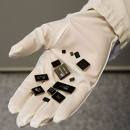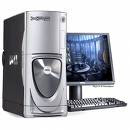We have conducted plenty of CPU reviews in our time, but we just can't bring ourselves to slow things down. The release of Windows Vista and a round of price cuts by AMD prompted us to hatch a devious plan involving Vista, a new test suite full of multithreaded and 64-bit applications, fifteen different CPU configurations, and countless hours of lab testing. That plan has come to fruition in the form of a broad-based comparison of the latest processors from AMD and Intel, ranging from well under $200 to a cool grand, from two slow CPU cores to four fast ones, from the lowly Athlon 64 X2 4400+ and Core 2 Duo E6300 to the astounding Athlon 64 FX-74 and Core 2 Extreme QX6700.
So, how do the latest processors stack up in Windows Vista? Will a sub-$200 CPU suffice for your needs? Have price cuts allowed the Athlon 64 to catch up to the Core 2 Duo in terms of price-performance? What about power consumption and energy efficiency? Can any of these processors stand up under the weight of killer new games like Supreme Commander? Can I possibly squeeze any more questions into one paragraph? Keep reading for answers to all of these questions and more.
The matchups
The setup for this one is fairly simple. We're directly comparing processors from Intel at AMD at a range of price points. Intel has had a lock on the overall performance lead since the Core 2 Duo first hit the scene, but AMD has made clear its intention to maintain a competitive price-performance ratio. To do so, AMD will have to meet or beat each of the processors in Intel's current desktop lineup, which looks like so:
Model Clock speed Cores L2 cache (total) Fab process TDP Price
Core 2 Duo E6300 1.83GHz 2 2MB 65nm 65W $183
Core 2 Duo E6400 2.13GHz 2 2MB 65nm 65W $224
Core 2 Duo E6600 2.4GHz 2 4MB 65nm 65W $316
Core 2 Duo E6700 2.66GHz 2 4MB 65nm 65W $530
Core 2 Extreme X6800 2.93GHz 2 4MB 65nm 75W $999
Core 2 Quad Q6600 2.4GHz 4 8MB 65nm 105W $851
Core 2 Extreme QX6700 2.66GHz 4 8MB 65nm 130W $999
Intel does offer lower cost options like the Core 2 Duo E4300 and its Celeron value-oriented processors, but our list includes the meat of the lineup.
AMD, on the other hand, offers a dizzying array of Athlon 64 X2 models, from 3600+ to 6000+, generally in increments of 200 (or is it 200+?). Not only that, but AMD often sells multiple products under the same performance-related model number, just to keep smug members of the general public from becoming overconfident. For instance, the Athlon 64 X2 4400+ comes in a 90nm "Toledo" flavor that runs at 2.2GHz, has 1MB of L2 cache per core, and is intended for Socket 939 motherboards. The X2 4400+ also comes in the form of a 65nm chip code-named "Brisbane" that runs at 2.3GHz, has 512K of L2 per core, and slips into Socket AM2 mobos. Several of these features—fab process, clock frequency, cache size, and socket/memory type—may vary within the same model number.
With that said, we've chosen the following members of the Athlon 64 lineup as the most direct competitors to their Core 2 counterparts. Because we live in the now, all of these are newer-style Socket AM2 processors:
Model Clock speed Cores L2 cache (total) Fab process TDP Price
Athlon 64 X2 4400+ 2.3GHz 2 1MB 65nm 65W $170
Athlon 64 X2 5000+ 2.6GHz 2 1MB 65nm 65W $222
Athlon 64 X2 5600+ 2.8GHz 2 2MB 90nm 89W $326
Athlon 64 X2 6000+ 3.0GHz 2 2MB 90nm 125W $459
Athlon 64 FX-70 2.6GHz 4 4MB 90nm 125W x 2 $599
Athlon 64 FX-72 2.8GHz 4 4MB 90nm 125W x 2 $799
Athlon 64 FX-74 3.0GHz 4 4MB 90nm 125W x 2 $999
As you can see, AMD has a fairly direct answer for most members of the Core 2 range. Things start to get shaky at the high end, where the Athlon 64's lower performance takes its toll. The Athlon 64 X2 6000+ sells at a discount versus the Core 2 Duo E6700, and AMD has no answer to the Core 2 Extreme X6800, Intel's fastest dual-core processor. If you match up the two product lines against one another, the results look something like this:
Model Price Model Price
Core 2 Duo E6300 $183 Athlon 64 X2 4400+ $170
Core 2 Duo E6400 $224 Athlon 64 X2 5000+ $222
Core 2 Duo E6600 $316 Athlon 64 X2 5600+ $326
Core 2 Duo E6700 $530 Athlon 64 X2 6000+ $459
Core 2 Quad Q6600 $851 Athlon 64 FX-72 $799
Core 2 Extreme QX6700 $999 Athlon 64 FX-74 $999
So the comparisons are remarkably direct, by and large.
These things are never entirely simple, though, so we should roll out some caveats. One of the big ones involves those FX-series processors. You'll need two of them in order to populate a Quad FX motherboard, so they're priced (and listed above) in pairs. However, there's currently only one Quad FX motherboard available, and it costs about $350, which throws the value equation out of whack.
The value equation sometimes goes off-kilter the other way when AMD employs guerrilla price-war tactics like selling the Athlon 64 X2 4600+ for $125.99 on Newegg, well below the slower 4400+. AMD has several of these "Crazy Hector" deals going at Newegg right now, and none of them seem to involve the Athlon 64 models we've identified as direct competitors to specific Core 2 Duo models. That's probably an intentional facet of AMD's strategy. This practice throws a wrench in our nice, neat comparsion, but there's little we can do other than tell you about it.
One other thing we should tell you about is why we've included two versions of the Athlon 64 X2 5000+ in our testing. Regular readers may recall that we've already tested the 65nm version of the 5000+ against its 90nm predecessor and found that the 65nm one had lower power consumption. But the 65nm version also has a slower L2 cache, so we've tested the 65nm and 90nm chips head to head to see
























